The Brazos Performance Preview: AMD E-350 Benchmarked
by Anand Lal Shimpi on November 16, 2010 12:01 AM ESTMemory and Cache Latencies
The Brazos platform was configured with 4GB of DDR3-1066 memory. The IDF system had memory running at DDR3-1333, however AMD had to decrease clocks presumably to meet validation requirements for final silicon. I measured an 86.9ns trip to main memory, a 3 cycle L1 and a ~22 cycle L2 cache. That's a lower latency memory interface than Atom or Core 2 based processors, but a higher latency L2.
CPU Performance: Better than Atom, 90% of K8 but Slower than Pentium DC
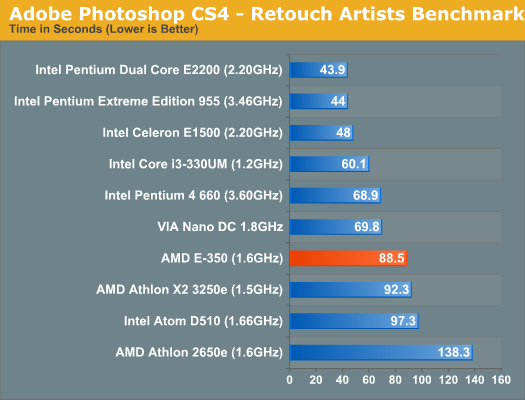
AMD's performance target for Bobcat was 90% of the performance of K8 at the same clock speed and our Photoshop CS4 benchmark shows that AMD can definitely say that it has met that goal. At 1.6GHz the E-350 manages to outperform a pair of K8s running at 1.5GHz in the Athlon X2 3250e. Unfortunately for AMD, Intel's Pentium dual-core running at 2.2GHz is much quicker. Most notebooks in the $400+ range have at least a 2.2GHz Pentium. Even the Atom D510 isn't far behind.
AMD tells me that in general purpose integer tasks, the E-350 should do well and it may even exceed AMD's 90% design target. However in higher IPC workloads, for example many floating point workloads, the E-350 is constrained by its dual issue front end. In these situations, the out of order engine is starved for instructions and much of Bobcat's advantage goes away.

Our x264 HD test has the E-350 performing within 86 - 92% of the Athlon X2 3250e, once again meeting AMD's design targets. Unfortunately, this isn't much faster than an Atom - mostly thanks to Atom's Hyper Threading support. Although not an out of order architecture, Atom gets a healthy efficiency boost by being able to execute instructions from two threads per core. Once again, compared to a 2.2GHz Pentium, the E-350 isn't close. Even VIA's dual core Nano is faster. When it comes to power consumption however, the E-350 can't be touched. I measured max system power consumption at 25.2W while running the x264 encode test. With the exception of the Atom D510, the rest of the desktop platforms here consume much more than that at idle (much less under load).
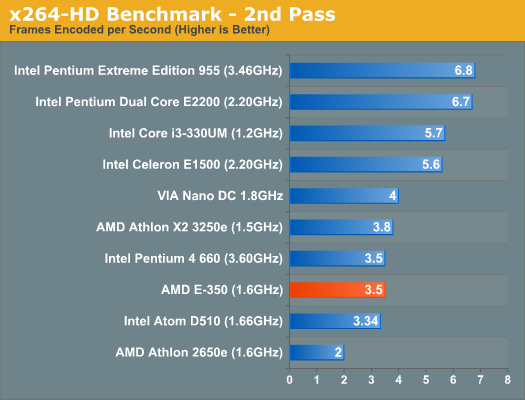
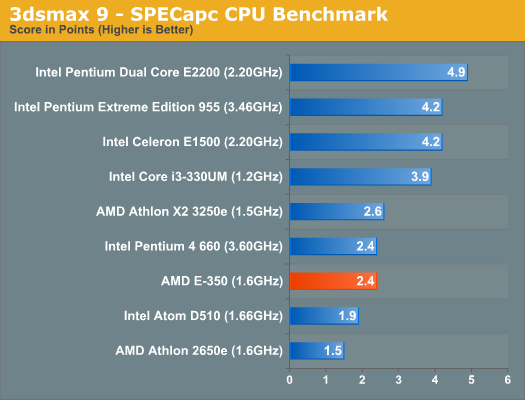
Despite being a offline 3D rendering benchmark, our 3dsmax 9 test does fall in line with expectations. The E-350 delivers 92% of the performance of the Athlon X2 3250e and outperforms the Atom D510 by 26%. Unfortunately for AMD, the Pentium dual-core holds onto a significant performance advantage here. Clock for clock, Bobcat won't be able to do much against anything Core 2 based. The real advantage here will be GPU performance.
Single Threaded Performance
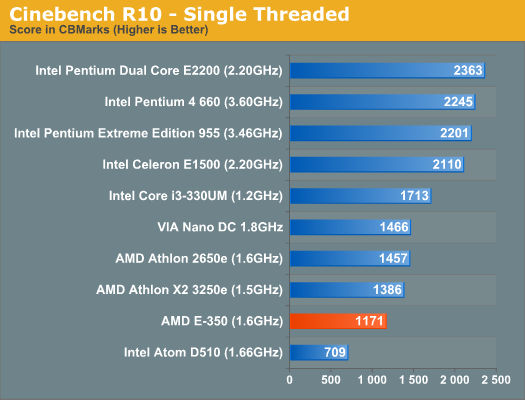
In most of our benchmarks the performance advantage over Atom isn't huge, yet using Brazos is much better than using an Atom based machine. It all boils down to one thing: single threaded performance. Atom can make up for its deficiencies by executing a lot of threads in parallel, but when you're bound by the performance of a single thread the E-350 shines. The E-350 is 65% faster than the Atom D510 in the single threaded Cinebench R10 test. It's this performance advantage that makes the E-350 feel so much quicker than Atom.
The Core i3-330UM manages a 46% performance advantage over the E-350. Even in the ultraportable Arrandale ULV space at lower clocks, AMD still leaves a lot of CPU performance on the table. The advantage here will be cost. A single E-350 is less than 40% of the die area of a Core i3-330UM. You may not get the same CPU performance, but performance per mm^2 is much higher.

In the multithreaded Cinebench test Atom is able to catch up quite a bit, but the E-350 still holds an 11% advantage.
File Compression/Archive Recovery Performance
Our final two CPU tests are both multithreaded and they show the E-350 equaling and falling behind the performance of the 1.5GHz Athlon X2. As we explained earlier, the gap between the E-350 and Atom shrinks as you add more threads to the workload.
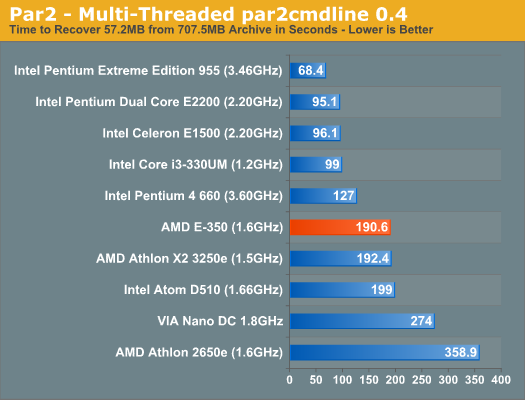
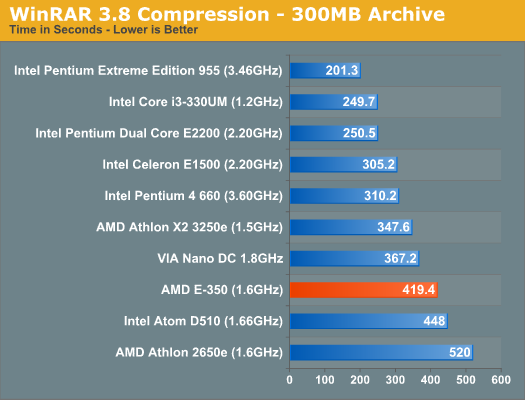










207 Comments
View All Comments
duploxxx - Tuesday, November 16, 2010 - link
When you mention this:In most of our benchmarks the performance advantage over Atom isn't huge, yet using Brazos is much better than using an Atom based machine. It all boils down to one thing: single threaded performance. Atom can make up for its deficiencies by executing a lot of threads in parallel, but when you're bound by the performance of a single thread the E-350 shines. The E-350 is 65% faster than the Atom D510 in the single threaded Cinebench R10 test. It's this performance advantage that makes the E-350 feel so much quicker than Atom.
and you only post mainly multithreaded apps which are fooled by the HT people off course get a different idea about the final product..... Atom is slow for booting and loading apps, perhaps a real world timing once the final silicon is there and compare the actual timing will give the brazos credit what it needs, afterall its 40nm vs 32nm and first silicon vs 2e revision.
so in the end not that bad, but AMd needs at least a 1.8-2.0GHZ brazos to compete in the 400-500$ range, that should be easy to get, they don't need more gpu power.
btw where is the stated 25W brazos amd has up its sleeves for the ultra low end desktop platform. THey can easily use it for notebooks.
duploxxx - Tuesday, November 16, 2010 - link
sorry anandtech, really big fan of your site, always the first site i will read, but this round other sites have done a much better job then your review. Again even your conclusion is totally off then others who are comparing the right platforms against each other....pcperspective really shows platforms, power consumption and guess what the results are :)
http://www.pcper.com/article.php?aid=1039&type...
Khato - Tuesday, November 16, 2010 - link
Eh, I wouldn't say other sites have done a better job, rather they just present different information. Given the fact that I was primarily interested in GPU performance aspects, the Anandtech review is far more useful far as I'm concerned.That said, the direct comparison against a celeron SU2300 ION platform is indeed interesting. A core 2 duo based celeron at 1.2GHz bests the 1.6GHz 'brazos' in CPU performance on all but the MP3 encode benchmark, which could just as easily be due to differences in the SSD used as the CPU. Sure the power numbers are impressive, but that's quite to be expected on a demo system - it'll be interesting to see how much that goes up on actual retail systems. aka, how stripped down and tweaked was the demo system in order to get idle power that low. It's basically equal to the SU2300 + ION on dynamic power according to those numbers.
duploxxx - Tuesday, November 16, 2010 - link
they all had the same amount of ram and all had ssd in that review, so it is really comaprable, where this review showed lots of different setups.Anand Lal Shimpi - Tuesday, November 16, 2010 - link
My goal was to compare to the type of CPUs you'd find in other $400 - $500 notebooks, mainly ~2.2GHz 1MB L2 Conroe/Merom based CPUs and 2.26GHz Arrandale based chips - both of which you'll see in the review.I agree we needed to include some ULV results, so this morning I added data from a simulated i3-330UM (1.2GHz) across the board :)
Take care,
Anand
khimera2000 - Tuesday, November 16, 2010 - link
intresting... I have to say that I got more out of this review then i did with anand since it uses the profile i would consider buying. I would not consider getting one of these chips for a notebook so the comparison against notebook chips are kinda lost to me.I was intrestead to see how much performance VS how much batterylife this new platform has since i already have a powerful desktop, a comprable notebook I dont need to know how fast a notebook is if its not hitting close to the 8 hour battary mark.
If i where to get one of these it would be for long flights and train rides, it would be for the children in my family, and it would be for the older people who are not as tech enabled. as it stands the questoins i had in mind where not easily answerd by anantech's review.
piroroadkill - Tuesday, November 16, 2010 - link
You've created Atom like performance with a slightly better GPU, way, way too late in the game.I thought the Dual core 1GHz and single core 1.2GHz would be more competitive with Atom 1.6, but looking at these results, those are in with no hope at all.
This is poor.
flyck - Tuesday, November 16, 2010 - link
read the reviews..... performance is better in multithreaded applications than Atom525 with HT and single threaded is 60% faster....gpu is better than ion which atom needs.
powerdraw on idle is LOWER than single core Atom and equal for cpu intensive tasks but higher in games.
mino - Tuesday, November 16, 2010 - link
Games which Atom cannot play in the first place.Not without Ion which makes the battery life goes boom anyway ...
Those GPU's are eating electrons like crazy when doing its job. Sneaky beasts, aren't they ? :D
Khato - Wednesday, November 17, 2010 - link
Really? It's power draw on idle is under the 7 watts measured on Anandtech for the single-core atom N450 Asus 1005PE? Maybe it's power consumption under load is lower than the 9.5 watts for that system?Yeah, power consumption figures vary wildly from system to system, especially when comparing netbook/notebook type designs to nettop/desktop. It's rather clear that the brazos test platform is a netbook/notebook type design and hence has no business being compared to nettop/desktop designs on power consumption.